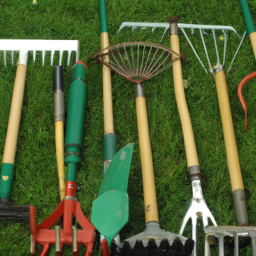Introduction
A garden rake is an essential tool for any gardener, whether you're a professional landscaper or a weekend warrior tending to your backyard. Rakes are versatile tools that can help with everything from leveling soil to gathering leaves and debris. With so many types of rakes on the market, it can be difficult to know which one is best suited for your needs. In this guide, we'll explore the different types of garden rakes, their uses, and tips on choosing the right one for your gardening tasks.
- Types of Garden Rakes
A. Leaf Rake: This is the most common type of rake and is designed for gathering leaves and other lightweight debris. The long, flexible tines make it easy to collect leaves without damaging your lawn or plants.
B. Bow Rake: Also known as a soil rake, this type of rake is designed for leveling and breaking up soil. It has short, sturdy tines and a flat head, making it ideal for preparing garden beds and spreading mulch.
C. Thatch Rake: This rake is specifically designed for removing thatch from your lawn. Thatch is the layer of dead grass that accumulates between the soil and the living grass, making it difficult for water and nutrients to reach the roots. A thatch rake has sharp, curved tines that cut through the thatch and pull it up to the surface.
D. Hand Rake: A smaller version of a leaf rake, a hand rake is ideal for working in tight spaces like flower beds and around shrubs. It's also useful for clearing small amounts of debris like leaves and twigs.
E. Adjustable Rake: This type of rake features an adjustable head, allowing you to change the width of the rake to suit your needs. This is particularly useful for raking around obstacles or in tight spaces.
- Uses of Garden Rakes
A. Soil Preparation: A bow rake is an essential tool for breaking up and leveling soil in your garden beds. It can also be used for spreading compost, mulch, or fertilizer.
B. Leaf Collection: Leaf rakes are designed to gather leaves and other lightweight debris without damaging your lawn or plants. They can make quick work of clearing your yard in the fall or after a storm.
C. Thatch Removal: Thatch rakes are specifically designed to remove thatch from your lawn, improving its health and appearance.
D. Garden Maintenance: Hand rakes are perfect for maintaining flower beds and other small areas of your garden. They can help you clear away debris and keep your plants looking neat and tidy.
E. Versatility: Adjustable rakes offer the ability to change the width of the rake head, making them useful for a variety of tasks and accommodating different garden layouts.
- Tips for Choosing the Right Garden Rake
A. Consider Your Needs: Think about the tasks you'll be using the rake for most often. If you primarily need a rake for gathering leaves, a leaf rake is the best choice. If you need a rake for leveling soil and spreading mulch, a bow rake is the way to go.
B. Material: Rakes can be made from a variety of materials, including metal, plastic, and wood. Metal rakes are generally more durable and long-lasting, while plastic rakes are lighter and more affordable. Wooden handles can offer a comfortable grip and a classic look.
C. Tine Material and Flexibility: Flexible tines are best for gathering leaves and other lightweight debris, while sturdy tines are more suited for breaking up soil or removing thatch.
D. Handle Length and Grip: Consider your height and the size of your garden when choosing a rake with the appropriate handle length. You'll want a rake that's comfortable to use and doesn't require excessive bending or reaching. A comfortable grip is also important for preventing hand fatigue during long periods of use.
E. Price: While it may be tempting to choose the cheapest rake available, investing in a higher-quality tool will save you money in the long run. A well-made rake can last for many years, while a cheaply made rake may need to be replaced after just a few seasons.
Conclusion
A garden rake is an essential tool for any gardener, but choosing the right one for your needs can be a bit overwhelming. By understanding the different types of rakes, their uses, and what to consider when purchasing one, you can make an informed decision and select the perfect rake for your gardening tasks. With the right rake in hand, you'll be well-equipped to keep your garden healthy, beautiful, and well-maintained.
